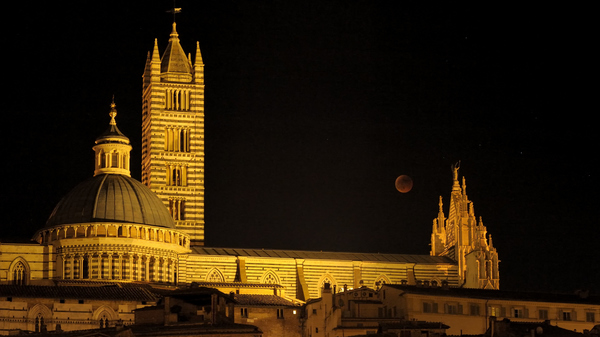Watching Lunar Eclipses
Lunar eclipses are some of the most easy-to-watch astronomical events. All you need to see them are clear skies and a pair of eyes.

Next Total Lunar Eclipse: 2025年3月14日金曜日 … See animation

A total lunar eclipse in Siena, Italy.
©thinkstockphoto.com
Viewing a Lunar Eclipse
Lunar eclipses occur on a Full Moon night when the Sun, Earth, and Moon are aligned in a straight line or almost straight line in space. Anyone on the night-side of the Earth at the time of the eclipse can see it.
Viewing most lunar eclipses requires little effort—partial and total eclipses of the Moon are very easy to see as long as you have a clear view of the Moon and the Sky.
Penumbral lunar eclipses, on the other hand, are much harder to observe.
Getting Started
- Use our Eclipse Calculator to find out if and when you can see a lunar eclipse at your location.
- Check the weather forecast so you can dress accordingly.
- Find a suitable place to view the eclipse. You should be able to see a lunar eclipse as long as you are on the night-side of the Earth when the eclipse occurs. Rural areas with little or no artificial lights have the clearest skies and the best viewing conditions. Urban areas, on the other hand, can provide interesting backdrops if you intend to photograph the eclipse.
Equipment
While you don't need any special equipment for viewing a lunar eclipse, astronomers and veteran photographers recommend some things that can make your lunar eclipse viewing experience even better.
These include:
- Binoculars: If you are interested in seeing the Moon's features during the eclipse, binoculars are handy to have. With binoculars, you can easily see changes in the Moon's color as the Earth's shadow moves over it. Some astronomers suggest viewing the Moon with binoculars at the start and end of totality to see a turquoise or blue band on the Moon. This band is caused by the upper, ozone-rich part of the Earth's atmosphere filtering the red wavelengths from the sunlight, giving it a blueish color.
- Telescope: A telescope can be helpful if you would like to see the features of the Moon in finer detail. You can also connect your DSLR camera to the telescope to get a bigger photo of the eclipsed Moon.
- Camera: You do not need any special equipment to take pictures of a lunar eclipse. A basic point and shoot or even a cell phone camera can be used.
- Tripod and cable releases: To keep binoculars or cameras steady, particularly for long focal-length shots or long exposures.
- Extra batteries: Make sure to charge all the all batteries, and bring extras.
- Flashlight: Helps to find your way in the dark.
Why is the Moon red during a total lunar eclipse?
How to Spot a Penumbral Eclipse
In a penumbral lunar eclipse, the Moon passes only through the fainter, outer part of the Earth's shadow, the penumbra. Because of this, it can be difficult to spot, and the eclipsed Moon can look like a regular Full Moon.
If the penumbral eclipse becomes deep (the penumbra covers a bit more than half of the Moon), you might be able to notice a slight darkening at the edge of the Moon in the deepest part of the shadow if you look very keenly.
Can't see it? Note that the Moon's orientation in the sky depends on the observer's latitude. This means the eclipse will appear to play out in different directions depending on your location. Use our eclipse animation to see how the eclipse appears in your city as the Earth's penumbral shadow moves across the face of the Moon.




